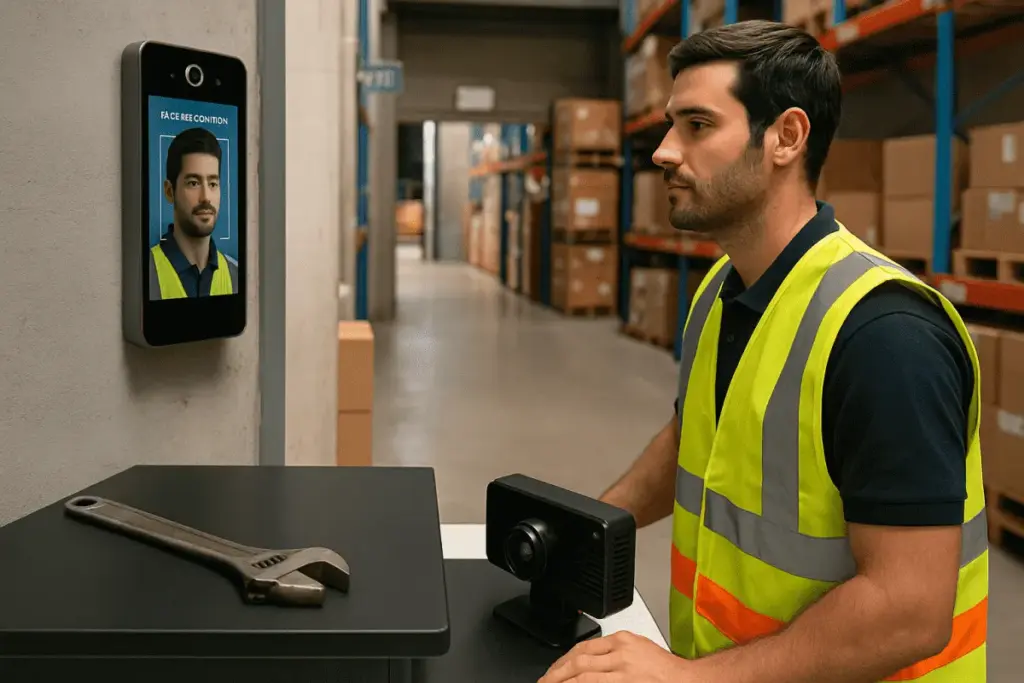Introduction: From Manual Scanning to AI Vision
AI warehouse management system technology has become essential for modern logistics, with over 45% of warehouses expected to deploy AI-powered solutions by 2025. ZedWMS leads this transformation by integrating object recognition cameras that eliminate manual scanning bottlenecks.
In traditional warehouses, every inbound or outbound operation depends heavily on manual barcode scanning, a process that becomes increasingly inefficient as volumes grow.
These issues not only slow down operations but also hinder traceability across supply chains that demand real-time inventory visibility. While our RFID warehouse management implementation has shown significant improvements, the next evolution combines RFID with AI vision for even greater accuracy.
1. Challenges in Traditional Operations
- Manual scanning consumes time and labor, especially during peak hours.
- Barcode damage or misplacement often causes scanning errors.
- Data synchronization delays lead to inaccurate stock levels.
These issues not only slow down operations but also hinder traceability across supply chains that demand real-time inventory visibility.
As industrial automation advances, it’s clear that the next evolution of warehouse management lies in AI vision — replacing barcode-centric workflows with camera-based object recognition that identifies, counts, and classifies items automatically.
2. AI + IoT: The New Era of Smart Warehouse Automation
Over the last three years, advancements in computer vision and edge AI have transformed manufacturing and logistics.
According to Gartner’s 2025 Digital Supply Chain report, over 45% of warehouses are expected to deploy AI-powered image recognition for AI inventory optimization to automate stock movement and verification.
This evolution is driven by three technological trends:
- Edge computing brings real-time inference closer to the camera.
- Lightweight AI models (like YOLOv8 and MobileNet) can run on compact processors such as RK3588 or NVIDIA Jetson.
- Integrated IoT platforms like ZedWMS provide the digital backbone to connect sensors, AI inference, and business logic.
3. How ZedWMS Changes the Game

ZedWMS, a next-generation AI warehouse management system, combines camera-based object recognition with IoT connectivity to create a fully automated inbound and outbound process.
Instead of relying on human scanning or RFID-only verification, ZedWMS uses AI vision cameras to detect, classify, and record every package or pallet entering or leaving the warehouse — in real time.
By embedding smart warehouse automation into the heart of logistics operations, ZedWMS reduces human dependency, ensures consistent accuracy, and provides immediate data synchronization with the central WMS dashboard.
Core Technology: How Object Recognition Camera Works in AI Warehouse Management System
AI camera recognition transforms image data into actionable inventory information.
In a warehouse, cameras positioned at entry and exit points capture real-time video streams of boxes, pallets, or containers. These video frames are processed through deep learning algorithms to detect, classify, and track every object.
1. The Recognition Workflow
The workflow can be summarized in five stages:
--- title: "AI Camera Object Recognition Workflow in Warehouse" --- graph LR %% ===== 样式定义 ===== classDef capture fill:#DCE8FF,stroke:#1A5FFF,stroke-width:2,rx:10,ry:10,color:#0B2161,font-weight:bold; classDef ai fill:#E0F7FA,stroke:#00838F,stroke-width:2,rx:10,ry:10,color:#004D40,font-weight:bold; classDef classify fill:#FFF8E1,stroke:#F57F17,stroke-width:2,rx:10,ry:10,color:#4E342E,font-weight:bold; classDef system fill:#E8F5E9,stroke:#0A7E07,stroke-width:2,rx:10,ry:10,color:#064C00,font-weight:bold; classDef alert fill:#F3E5F5,stroke:#6A1B9A,stroke-width:2,rx:10,ry:10,color:#311B92,font-weight:bold; %% ===== 节点定义 ===== A["📷 Camera Capture(Boxes, Pallets, Forklifts)"]:::capture B["🧠 Edge AI Detection(YOLOv8 / RK3566)"]:::ai C["🔍 Object Classification(Type • Quantity • Barcode • Label OCR)"]:::classify D["🔗 ZedWMS Sync(Inbound / Outbound / Inventory Update)"]:::system E["📊 Dashboard UpdateReal-time Alerts & KPI Metrics"]:::alert F["♻️ Automated Actions(AGV Dispatch • Putaway • Pick Instruction)"]:::system %% ===== 流程连接 ===== A --> B B --> C C --> D D --> E E --> F F -.-> D %% ===== 链接线条设置 ===== linkStyle default stroke:#555,stroke-width:1.8;
- Camera Object Recognition Capture: HD or industrial cameras installed at gates and conveyors capture frames continuously.
- Edge AI Detection: Models such as YOLOv8 detect objects within milliseconds, even in dynamic environments.
- Object Classification: Detected items are categorized by type, quantity, and label, eliminating manual counting.
- ZedWMS Data Sync: Recognized data is pushed via MQTT or REST API to the ZedWMS platform.
- Dashboard & Alerts: The web dashboard reflects updates in real time, triggering alerts for exceptions or discrepancies.
Object recognition AI processes visual data into structured inventory events, bridging the gap between the physical and digital layers of warehouse management.
2. The Algorithms Behind Object Recognition
ZedWMS leverages a hybrid approach of YOLOv8, MobileNet, and TensorRT acceleration for optimized inference.
| Algorithm | Function | Application in Warehouse |
|---|---|---|
| YOLOv8 | Real-time object detection | Detect boxes, pallets, and small items on conveyors |
| MobileNetV3 | Lightweight classification | Identify item category or packaging type |
| TensorRT | Hardware optimization | Accelerate inference on edge devices (RK3588, Jetson Nano) |
These algorithms are trained on diverse warehouse datasets, covering variations in lighting, orientation, and packaging color.
In combination with edge AI, detection latency can drop below 100 ms, supporting instant inbound or outbound validation.
The object recognition camera system leverages advanced object recognition AI algorithms, including:
3. Edge + Cloud Collaboration
While edge devices perform the heavy lifting for object recognition, the ZedWMS Cloud handles data aggregation, historical storage, and AI model updates.
- Edge AI: Real-time object detection and temporary caching.
- Cloud AI: Model retraining and performance analytics.
- Data Sync: MQTT or WebSocket ensures live synchronization of stock events.
This dual-layer architecture ensures that even if the network drops, the edge node continues to operate independently and later syncs once connectivity resumes — ensuring zero data loss in warehouse automation.
4. Why Vision Outperforms Barcode Scanning
Comparing traditional barcode systems with modern camera object recognition technology:
| Comparison | Barcode System | AI Vision System |
|---|---|---|
| Identification Method | Laser scanning | Object recognition |
| Speed per item | 1–2 seconds | <0.2 seconds |
| Damage Tolerance | Low (barcode dependent) | High (object-based detection) |
| Data captured | Single label | Multi-attribute (type, count, status) |
| Automation level | Semi-manual | Fully autonomous |
The shift from barcode to AI vision represents a fundamental evolution in how warehouses perceive and record physical inventory — transforming visual information into structured, real-time operational data.
Integration with ZedWMS: Real-Time Inbound & Outbound Management
Traditional warehouse software relies on handheld barcode terminals and human verification.
In contrast, ZedWMS's object recognition camera directly integrates into the inbound and outbound workflow,
transforming every camera feed into a real-time inventory data source.
1. From Visual Detection to Data Synchronization
When a shipment enters or leaves the warehouse, AI cameras automatically identify boxes, pallets, or parcels.
The recognition results — including item count, classification, and condition — are immediately transmitted to ZedWMS, which matches them against expected orders or stock records.
This process eliminates manual confirmation steps:
- Inbound — As goods arrive, the camera verifies each package and syncs data with the supplier delivery list.
- Outbound — During dispatch, the system cross-checks the recognized objects with the picking list, ensuring no discrepancies.
- Stock Update — ZedWMS automatically updates stock levels in real time, maintaining consistent accuracy between physical and digital inventory.
By combining AI vision and camera-based inventory tracking, ZedWMS ensures every operation is verified at the moment it occurs — no handheld scanners, no waiting for uploads.
2. Intelligent Location Mapping and Traceability
Each identified item is linked to a warehouse location code, enabling automatic tracking of where it was stored, picked, or shipped. This capability integrates seamlessly with our equipment asset management solution to provide complete visibility of both inventory and warehouse equipment.
This integration with the warehouse’s location mapping system allows ZedWMS to maintain:
- Precise pallet positioning within racks or zones.
- Real-time path tracing from inbound receiving to outbound loading.
- Instant video evidence tied to every transaction record.
For example, when a package is misplaced or damaged, the corresponding video segment and data log can be retrieved instantly — simplifying audits, insurance claims, and quality control.
3. System Interaction and Efficiency Overview
ZedWMS’s modular design enables flexible integration with multiple data sources — cameras, RFID readers, or barcode scanners — forming a hybrid AI + IoT environment.
Below is an overview of how each module contributes to system intelligence and operational gains.
| Function Module | Data Source | Technical Implementation | Efficiency Improvement |
|---|---|---|---|
| Inbound Entry | AI Camera + Barcode Cross-Check | Real-time object detection and verification | Speed increased by 60% |
| Outbound Picking | Object Tracking + RFID | Automated quantity matching and validation | Accuracy reaches 99% |
| Stock Audit | Edge AI Snapshot | Automated cycle counting and restocking check | Labor cost reduced by 70% |
| Exception Alerts | AI Event Recognition | Immediate dashboard notification | Error detection within seconds |
| Data Analytics | ZedWMS Cloud | Continuous KPI tracking | Smarter resource allocation |
This hybrid approach doesn't discard existing barcode infrastructure — it enhances it with AI object recognition, ensuring smooth adoption without system overhaul.
For environments requiring precise location tracking, this system also complements our RFID and UWB tracking solutions, providing multiple layers of verification.
System Architecture: Edge + Cloud Intelligence
To sustain real-time processing at industrial scale, ZedWMS uses a distributed Edge + Cloud architecture that separates heavy AI inference from data management and analytics.
1. The Architecture Overview
--- title: "ZedWMS AI Vision Warehouse" --- graph TD %% ===== 简洁配色(高对比) ===== classDef sense fill:#DCE8FF,stroke:#1A5FFF,stroke-width:2,rx:10,ry:10,color:#0B2161,font-weight:bold; classDef edge fill:#E0F7FA,stroke:#00838F,stroke-width:2,rx:10,ry:10,color:#004D40,font-weight:bold; classDef cloud fill:#E8F5E9,stroke:#0A7E07,stroke-width:2,rx:10,ry:10,color:#064C00,font-weight:bold; classDef app fill:#FFE0B2,stroke:#E65100,stroke-width:2,rx:10,ry:10,color:#6A3D00,font-weight:bold; %% ===== 第 1 层:感知层 ===== subgraph L1["① Sensing"] direction TB CAM["📷 Camera Sensors"]:::sense end %% ===== 第 2 层:边缘智能 ===== subgraph L2["② Edge AI"] direction TB EDGE["🧠 Edge AI Node• Detection (YOLOv8)• OCR / Barcode"]:::edge end %% ===== 第 3 层:云端核心 ===== subgraph L3["③ ZedWMS Cloud"] direction TB API["API Gateway"]:::cloud EVT["Event Processor / Rules"]:::cloud INV["Inventory Service"]:::cloud API --> EVT --> INV end %% ===== 第 4 层:应用与可视化 ===== subgraph L4["④ Applications"] direction TB DASH["📊 Dashboard & Analytics"]:::app MOB["📱 Mobile App / API Clients"]:::app end %% ===== 主数据流(自上而下) ===== CAM -->|"Video/Frames"| EDGE EDGE -->|"Telemetry / Events (MQTT/HTTPS, TLS)"| API INV --> DASH INV --> MOB %% ===== 可选回路(配置/模型下发) ===== API -. "Config / OTA (Policies, Model)" .-> EDGE
- Object Recognition Camera Sensors: High-resolution industrial cameras capture continuous streams at dock doors, conveyors, or picking areas.
- Edge AI Node: Devices like RK3588 or NVIDIA Jetson Nano run YOLOv8 models locally for instant recognition.
- ZedWMS Cloud: Aggregates all object data, maintains transaction logs, and synchronizes stock states.
- Dashboard & Analytics: Offers real-time visualization of inbound/outbound flow, alerts, and performance metrics.
- Mobile App / API: Allows operators and managers to access live data and notifications remotely.
This structure provides low-latency processing while ensuring cloud-level visibility — the foundation of a modern AI-powered warehouse solution.
2. Edge AI in Warehouse Automation
Edge AI nodes function as autonomous intelligence units deployed near cameras.
They execute detection, classification, and event tagging locally, significantly reducing the bandwidth and cloud compute costs.
Benefits of Edge Deployment:
- <100ms latency for object detection.
- Offline resilience: Operations continue even if the internet is temporarily disconnected.
- Data privacy: Visual data stays within the local network, while only metadata is transmitted to the cloud.
This ensures that warehouses can operate securely and efficiently — even in remote or large-scale environments where continuous connectivity cannot be guaranteed.
3. Real-Time Alerts and Event Monitoring
ZedWMS integrates edge AI analytics with MQTT-based event channels.
Whenever a mismatch, missing item, or unexpected object is detected,
the system instantly pushes alerts to the dashboard and mobile app.
Typical alerts include:
- “Unregistered pallet detected at Dock 3.”
- “Outbound mismatch – 1 item unscanned.”
- “Stock deviation from last audit detected.”
These real-time notifications transform warehouse operations from reactive correction to proactive intelligence.
Real-World Use Cases: How AI Vision Transforms Warehouse Operations
The deployment of ZedWMS with AI camera recognition has already shown measurable results in multiple industrial environments.
Below are three representative case studies demonstrating how visual intelligence can automate inbound/outbound processes and improve operational control.
Case 1 — Electronics Component Warehouse
Scenario:
A high-volume electronics distributor needed faster inbound verification for thousands of component trays arriving daily.
Solution:
ZedWMS integrated AI cameras above the receiving area. As trays arrived on pallets, the system automatically detected, counted, and matched them to purchase orders.
Results:
- Inbound registration time reduced from 6 minutes to under 2 minutes per pallet.
- Errors caused by manual barcode scanning dropped by 90%.
- Live dashboard updates allowed procurement and inventory teams to track arrivals instantly.
Case 2 — E-Commerce Fulfillment Center
Scenario:
An e-commerce logistics operator struggled with outbound delays and mismatched package counts during peak hours.
Solution:
Edge AI cameras equipped with YOLOv8 recognition were installed above conveyor belts. Each package was recognized by shape, size, and label. The system automatically synchronized the data with ZedWMS to verify outbound lists.
Results:
- Sorting accuracy improved to 99.5%.
- Outbound speed increased by 65%.
- Real-time video traceability helped resolve delivery disputes efficiently.
Case 3 — Pharmaceutical Logistics Center
Scenario:
A pharmaceutical warehouse required temperature-controlled storage and strict item traceability for medical supplies.
Solution:
AI cameras integrated with environmental sensors monitored both visual identification and temperature/humidity data. ZedWMS correlated these readings to ensure compliance with regulatory requirements.
Results:
- Full traceability for all batches.
- Automated quality checks with AI-driven alerts.
- Significant reduction in manual inspection labor.
Advantages and ROI: Tangible Business Outcomes
| Dimension | Result | Description |
|---|---|---|
| Time Efficiency | 2–3× faster operations | Real-time AI Object recognition detection eliminates manual scanning |
| Accuracy | 99%+ verification | Dual validation through vision + WMS data |
| Labor Cost Savings | 40% workforce reduction | Automated inbound/outbound and cycle counts with AI inventory optimization |
| Traceability | Full video + data linkage | Visual evidence supports audits and quality checks |
| Scalability | Edge-cloud expandable | Supports multiple sites under a unified AI warehouse management system |
By embedding AI camera systems for AI inventory management within existing workflows, companies realize both operational gains and ROI within months.
Beyond productivity, the visual layer adds transparency, ensuring that every inventory movement is visible, verifiable, and compliant.
Future Outlook: AI + Digital Twin for Warehouse 5.0
The next evolution of warehouse management will integrate AI vision, digital twins, and autonomous robotics into a unified ecosystem powered by advanced AI inventory optimization.
ZedWMS is already evolving in that direction.
1. Digital Twin Visualization
By building a 3D digital twin of the warehouse, every pallet, shelf, and AGV robot can be monitored in real time.
AI camera monitoring feeds and sensor data update the digital twin dynamically, offering immersive, real-time situational awareness.
2. Self-Learning AI Models
Continuous learning enables the system to recognize new object types, packaging variations, or anomalies such as misplaced goods and damaged boxes. The camera object detection and recognition capabilities improve through continuous learning.
Through edge-to-cloud model retraining, accuracy improves automatically over time
enhancing AI inventory management accuracy.
3. Robotics and AGV Collaboration
AI cameras system provide the eyes, while AGV and robotic arms provide motion.
ZedWMS coordinates both via APIs and MQTT channels, similar to how our equipment asset management system tracks and manages warehouse machinery and AGVs in real-time, creating a fully autonomous logistics flow — from detection to pickup to placement.
4. The Intelligent Core of Warehouse 5.0
In this vision, ZedWMS becomes the central nervous system of smart logistics —
a platform that connects perception (AI vision), decision (data analytics), and action (robotics) in one seamless loop.
Redefining Warehouse Efficiency with ZedWMS
AI camera monitoring has shifted the paradigm of warehouse management from manual scanning to real-time automation. Object recognition camera technology replaces traditional scanning
With this AI warehouse management system, every camera becomes a smart sensor, every frame a data point, and every operation a verifiable event.
Key Takeaways:
- AI object recognition camera replaces slow, error-prone barcode scanning.
- Edge + Cloud architecture ensures fast, reliable, and secure operation.
- Real-world deployments already demonstrate higher accuracy and faster turnover.
- The AI warehouse management system lays the foundation for future digital-twin and robotics integration
through AI inventory optimization.
ZedWMS is not just another warehouse management system —
it’s an AI-powered orchestration platform for AI inventory management.
Experience how ZedWMS transforms your AI warehouse management system with AI camera monitoring and AI inventory optimization.
Contact our team today to schedule a live demo or pilot deployment.


